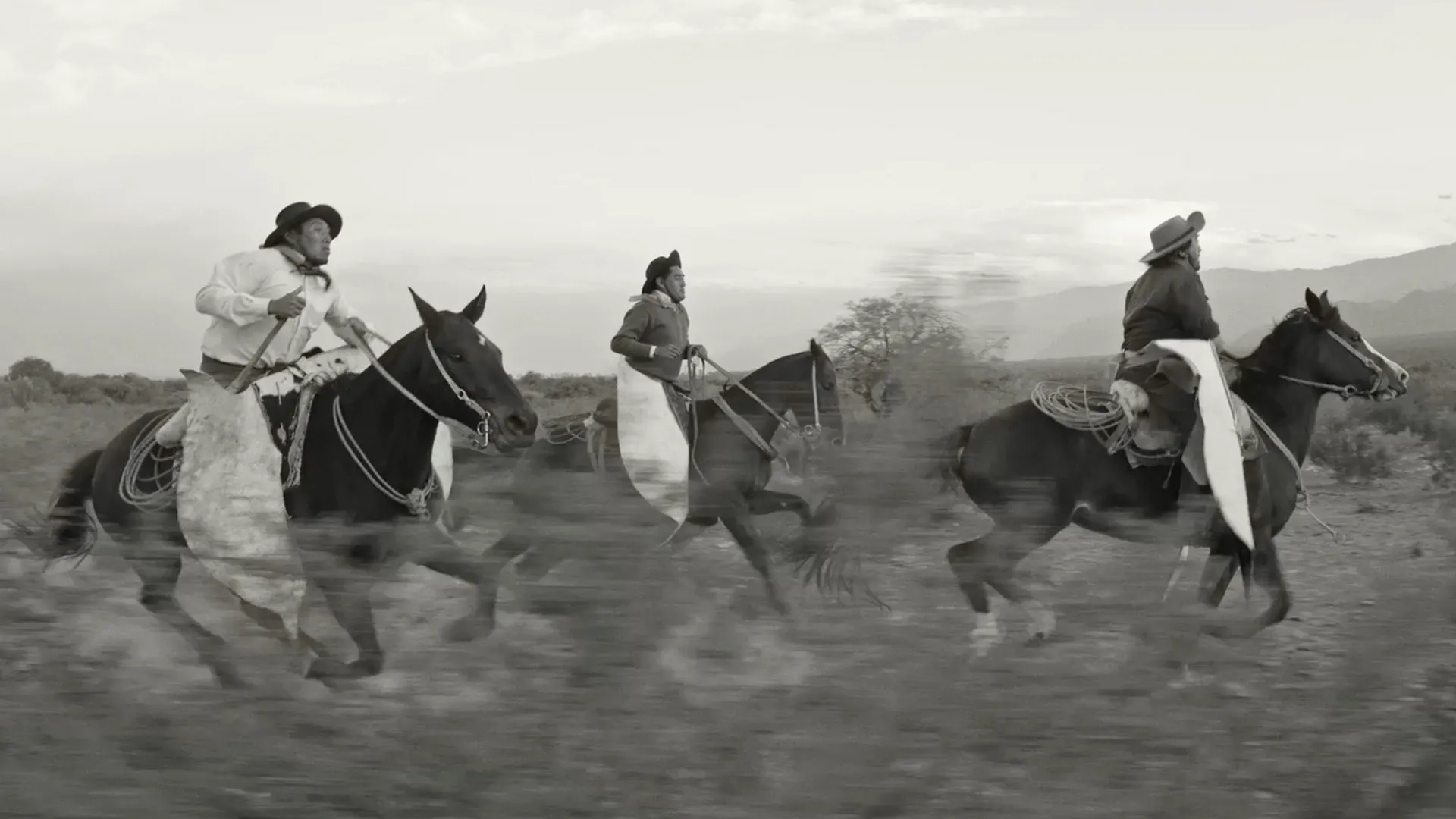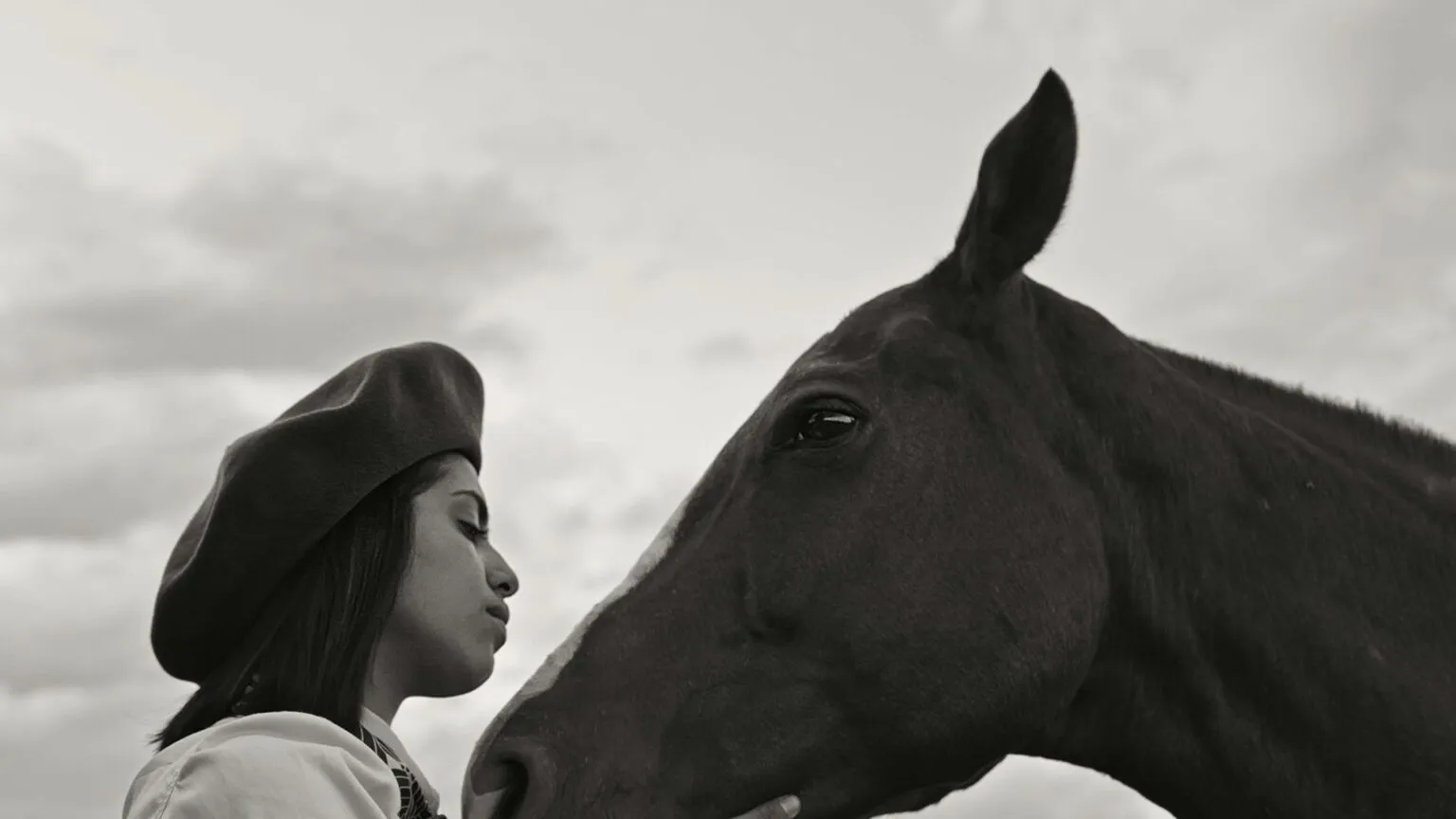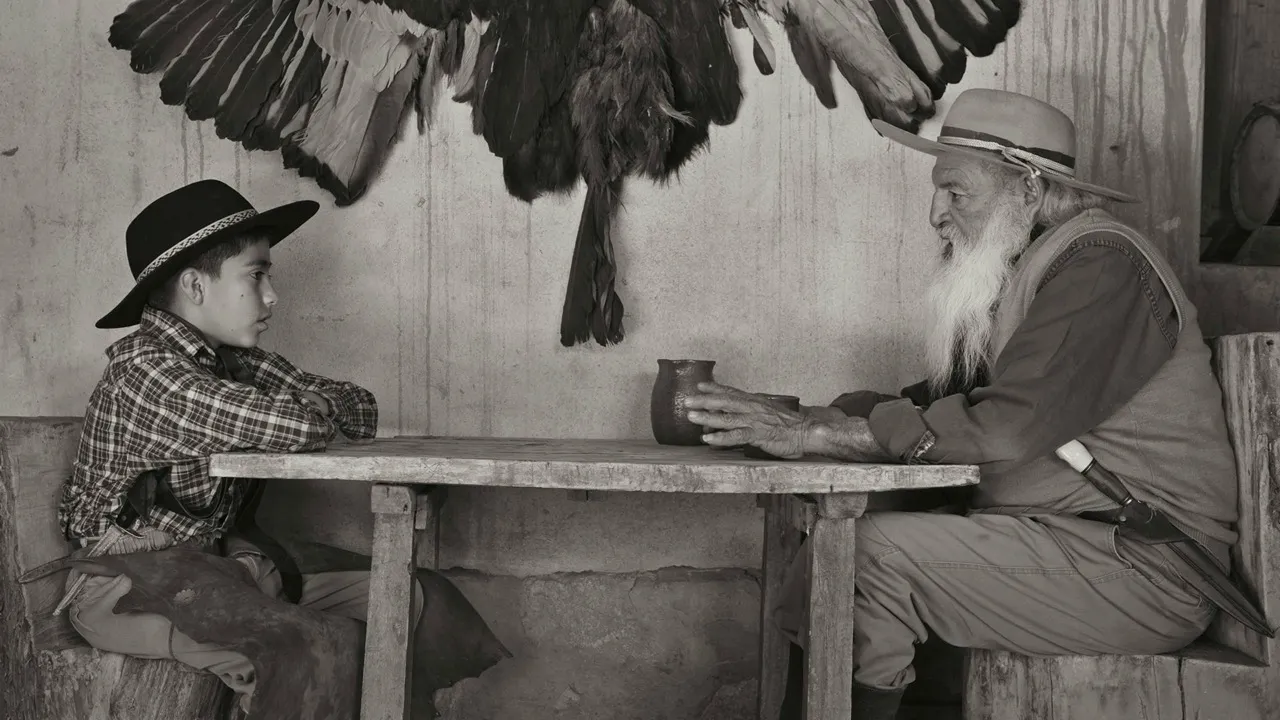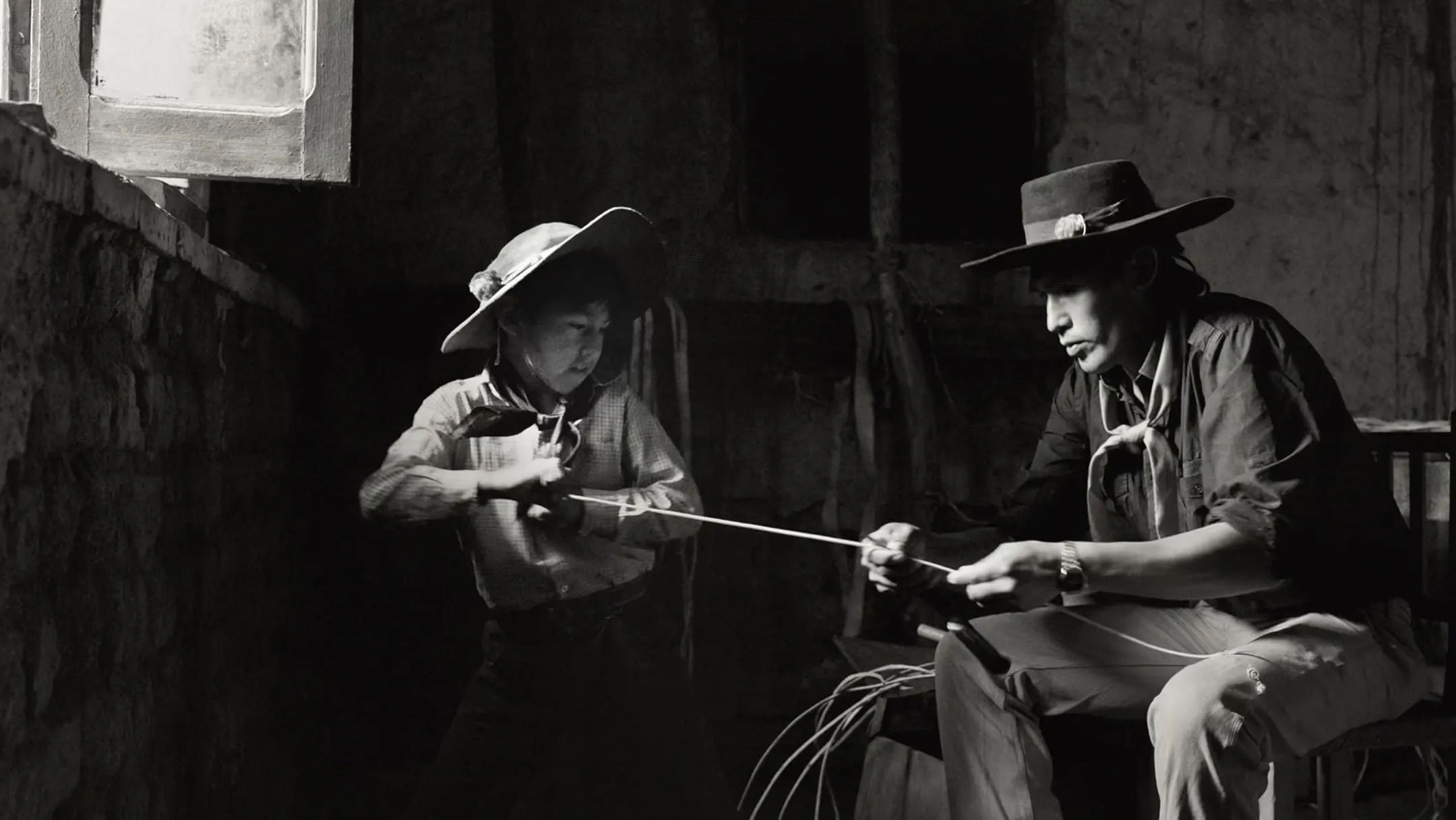The black-and-white cinematography in Gaucho Gaucho is more than just a matter of taste; it creates a melancholy interplay between memory and reality, a chiaroscuro that reflects the complexities of existence in the Gaucho community. In this one-color world, the gauchos are more than just folkloric figures; they become ghostly representations of tradition, fighting against the void that modernity is filling.
Each frame is carefully made, revealing the rough beauty of Argentina’s land, where the vast skies watch over the plains like silent witnesses to human progress. The slow reveal of a gaucho waking up in the opening shot encapsulates the existential questioning of the film, suggesting that there is a deep, though unyielding, connection to both land and family in the stillness.
The directors’ skilled use of slow motion and tracking shots makes this contemplative study even more real for the viewer. As cowboys gallop across the distance, time seems to stretch, giving us a chance to enjoy fleeting moments full of life but also hinting at how time will always be moving on. Each ride is a dance with fate, and each movement is a reminder of life’s transient nature.
These methods highlight the gauchos’ physical prowess and encourage reflection on their existence’s fragility. Gaucho forces us to confront the shadows that lurk beneath the surface of tradition and the haunting question of what it means to be truly alive in a world that relentlessly marches forward through such visual poetry.
Echoes of Tradition: The Gaucho Identity in Gaucho Gaucho
Tradition in Gaucho Gaucho serves as both a haven and a chain, embodying the duality of the gaucho identity. The film transports us to a world where time-honored customs like honoring Pachamama, herding cattle, and making leather are more than just traditions; they are lifelines that connect people to a shared spiritual past.
These traditions are acts of respect and a testament to resilience in the face of modernity’s unrelenting march. They represent a symbiotic relationship with the land that goes beyond just survival. As we watch the gauchos do group activities, their routines evoke an almost primal connection, suggesting that in a world where people are increasingly more alone, these shared moments offer a fleeting glimpse of belonging.
Still, a quiet rebellion is going on in this tapestry of manhood. Guada, a young woman who has to deal with the gaucho way of life, which is mostly male, becomes a powerful symbol of defiance against ingrained gender roles. Her refusal to fit in, which is most obvious when she wears traditional gaucho clothes to school, goes against the strict rules that have traditionally kept women in their places.
As Guada tries to fit in with a world that values machismo, she is going through a greater existential struggle: she is trying to find her own identity in a world that wants to define it. Her journey, which was motivated by her own goals and what society thought she should do, raises troubling questions about the nature of freedom and the cost of authenticity in a community that holds on to its traditions like a lifeline. Gaucho Gaucho celebrates the resilience of gaucho culture through Guada while also illuminating the darker parts of tradition that fight change.
Threads of Legacy: Character Dynamics in Gaucho Gaucho
The characters in Gaucho Gaucho become live examples of tradition and change, with each story thread weaving into a complex tapestry that reflects the complexities of the gaucho life. Guada is the main character. She is a young woman fiercely determined to accept her identity despite the constraints of a patriarchal society. Her journey is not just personal; it resonates with a larger existential question about the cost of authenticity in a world that frequently requires conformity.
We can see the struggle of a generation stuck between the weight of family obligations and the need to find their own identity in her eyes. Solano, her father, is full of wisdom from years of experience. He teaches his son Jony the subtleties of gaucho life with a tender sense of urgency. Each lesson—like sharpening a knife or braiding a rope—becomes a symbol for passing on values from one generation to the next. This shows how important legacy is when the future is unclear.
Lelo, the older Gaucho, has a different point of view. The film has a sad, serious tone because of his memories of an exciting life and the bittersweet acceptance of getting older. His stories are haunted by the ghost of time’s passage while also evoking the laughter of youth. He serves as a link between the past and present. A lot is going on between him and the younger gauchos. There is respect, but there is also tension that comes from knowing that their world is changing.
There is a lot of love and unease in the mentoring that goes on in this community. As Solano teaches Jony, they share moments together where they both know something without saying it: information is like a double-edged sword—it can be a gift or a burden. In these conversations, Gaucho Gaucho shows in a moving way how the path of tradition is riddled with existential conundrums: what should be kept, what should be lost, and who should make the final decision? The film makes us ponder these issues and leaves us with a lingering sense of unease and a reminder that every act of teaching carries the weight of history and the power to change things.
The Tension of Time: Tradition vs. Modernity in Gaucho Gaucho
The gauchos in Gaucho Gaucho are the guardians of an old way of life who fiercely fight against the advances of modernity that threaten to destroy their traditional identity. In a world that values speed over content more and more, their daily rituals, like the careful art of herding cattle or the group ceremonies honoring Pachamama, are acts of defiance.
The film beautifully depicts these moments: a gaucho’s steady hand braiding leather, the steady beat of hooves against the ground, each act reaffirming existence in the face of time’s unrelenting advance. This resistance isn’t just nostalgic; it’s a strong statement of identity and a refusal to let the noise of progress drown out the whispers of history.
Still, there is a current of change running through this stability. Even though the gauchos are very attached to their traditions, they are not completely closed off to new ideas. Scenes that show Guada’s brave attempts to compete in rodeos show how roles have changed over time in the community, fusing traditional practices with modern ways to express identity. Her journey reflects a more complex view of adaptation: tradition doesn’t have to be a set of rules that can’t be changed; it can be a living, breathing thing that can change.
This duality of resistance and adaptation raises unsettling questions about the nature of progress. The gauchos represent the tension between preserving the past and welcoming the future as they move through the complexities of existence. Gaucho invites us to ponder the existential weight of cultural heritage and the delicate balance between upholding tradition and carving out a new path in doing so. Each choice made by the gauchos resonates through time, pointing to the larger implications for future generations caught in this delicate interplay of legacy and change.
Resonant Echoes: The Soundscape of Gaucho Gaucho
When you watch Gaucho Gaucho, the music mixes different cultures. It has traditional Argentine melodies and modern elements that bring the gaucho experience to life. A rich auditory tapestry that resonates with the themes of identity and resilience in the film is created by the eclectic mix, which ranges from the spirited strumming of a folk guitar to Bizet’s operatic heights.
The haunting strains of slower ballads reflect the melancholy of Guada’s struggle against tradition, while the pulsing rhythms convey a sense of urgency as she deals with her challenges. Each track serves as an emotional lens through which the viewer can comprehend the complexities of the gaucho world rather than just as background noise.
As you play, the sound design adds to the immersion by adding background sounds that bring the landscape to life, like the thundering of horse hooves on the ground and the faraway calls of condors flying above. The viewer is grounded in the visceral truth of gaucho life by these elements, which are not just background noise but essential to the film’s narrative.
When put next to the vast, lonely Argentine plains, a fleeting moment like the crackle of a campfire becomes a powerful reminder of warmth and community. Gaucho Gaucho urges us to reflect on the echoes of existence that linger in both the silence and the song in this interplay of music and sound.
Heartbeats in the Dust: Emotional Resonance in Gaucho Gaucho
Gaucho Gaucho expertly strikes the fine line between fun and seriousness, creating moments that make you laugh aloud while raising existential questions. Guada’s spirited statement of identity is a lighthearted rebellion in one endearing scene in which she defies her school’s uniform policy, making people laugh.
These funny moments are very important because they break up the film’s serious themes and remind us that even in the struggle to preserve culture, joy and warmth can grow. The harsher conditions the gauchos face are softened by this interplay of humor, which paints a complex picture of resilience.
However, the film’s powerful emotional beats linger in the mind long after the credits roll. The tender conversations between Solano and his son Jony, tinged with quiet pride and fear, hit home deeply, illuminating the close bonds created by shared traditions. We are asked to empathize with the weight of history carried by these characters in scenes that capture the worn-out look on Lelo’s face as he reflects on a life well-lived.
Each emotional high point confronts the audience with the harsh reality of a society on the verge of change and highlights the beauty of its existence. Through these moments, Gaucho Gaucho forces us to confront our connections to time and the passing of time, eliciting a deep empathy for a way of life that is both legacy-less and fleeting.
The Art of Observation: Immersion in Gaucho Gaucho
Gaucho is directed by Dweck and Kershaw, who use an observational style that goes beyond traditional storytelling to immerse the audience in a gaucho’s real, unvarnished life. The filmmakers want us to be witnesses instead of observers by not using interviews or standard story structures.
This method fosters a sense of closeness as we are given access to the routines and unplanned moments that define the characters’ existence. The lack of overt commentary enables the gauchos to communicate through their actions, revealing the weight of their traditions and the complexities of their struggles without outside interpretation.
When filmmakers follow this approach, they make engaging movies that pull viewers into the big but small world of the gauchos. We can feel the ground vibrating with every step, hear the calls of animals far away, and sense the tension in the family. This kind of attention to detail makes a deep connection between the audience and the subject, letting us share their joys and sorrows.
The fragility of existence is, however, revealed in this immersion, which is unsettling. The gaucho filmmakers capture the land’s beauty, but so are the shadows of modernity threatening the gaucho’s way of life. This duality of celebration and impending loss creates an emotional depth that makes us reflect on our lives and invites us to ponder the delicate balance between tradition and change, connection and isolation. By showing these gauchos with respect, Dweck and Kershaw tell us that their stories are not just theirs; they are part of the human experience and reflect our existential questions.
The Review
Gaucho Gaucho
The movie Gaucho Gaucho is a moving look at tradition and identity. It mixes humor with the sad truths of a culture at a turning point very well. The film's observational style draws viewers into the world of the gauchos, making them feel deeply moved and reflect on the delicate balance between tradition and modernity. This film is a potent example of the resilience of the human spirit because of Dweck and Kershaw's respectful portrayal, which encourages us to confront existential questions about belonging and change.
PROS
- Captures the essence of gaucho culture with respect and depth.
- Beautifully shot, drawing viewers into the landscape and lifestyle.
- Balances humor and seriousness, evoking genuine empathy.
- Creates an intimate connection with characters through natural interactions.
CONS
- Some may find the slow pacing challenging.
- Absence of interviews or structured plot may feel disorienting to some viewers.





















































